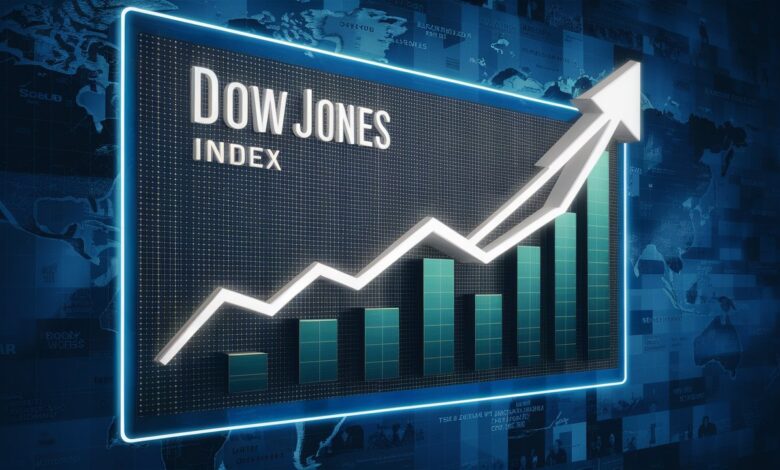Dow Jones Today: Resilience Amid Geopolitical Tensions and Fed Uncertainty

Dow Jones Industrial Average (DJIA)
42,206.82 | +35.16 (+0.08%)
As of June 20, 2025, Market Close
Market Performance Highlights
The Dow Jones Industrial Average defied broader market weakness on June 20, 2025, edging up 35.16 points (0.08%) to close at 42,206.82. This marginal gain contrasted with the S&P 500’s 0.22% decline to 5,967.84 and the Nasdaq Composite’s 0.51% drop to 19,447.41. Despite geopolitical headwinds, the Dow secured a 0.02% weekly gain, its second consecutive weekly advance. The index demonstrated remarkable resilience, trading just 3% below its 52-week high of 45,073.63 (set December 4, 2024), as prior peaks “act like rusty doors,” requiring multiple attempts to breach decisively according to CFRA’s Sam Stovall 145.
Table: Key Index Performances (June 20, 2025)
| Index | Close | Change | Weekly Change |
| Dow Jones | 42,206.82 | +0.08% | +0.02% |
| S&P 500 | 5,967.84 | -0.22% | -0.20% |
| Nasdaq | 19,447.41 | -0.51% | +0.20% |
Geopolitical Tensions and Market Sentiment
Middle East conflicts cast a long shadow over trading. Reports indicated Israeli Prime Minister Benjamin Netanyahu ordered strikes on “strategic targets” in Iran, while President Donald Trump deliberated on direct U.S. involvement. The White House confirmed Trump would decide within two weeks whether to join Israeli military action against Tehran. This uncertainty triggered a cautious “risk-off” approach ahead of the weekend, particularly impacting technology stocks with higher volatility profiles. European diplomatic efforts to de-escalate tensions failed during Geneva talks, amplifying market anxiety about potential oil supply disruptions. Despite initial price spikes earlier in the week, Brent crude retreated 2.5% to $77.20/barrel on Friday amid hopes for negotiated solutions 135.
Federal Reserve Policy Divergence
Monetary policy uncertainty amplified market volatility. Federal Reserve Governor Christopher Waller ignited early optimism by suggesting the central bank could cut rates “as early as July.” However, this conflicted sharply with Fed Chair Jerome Powell’s Wednesday stance advocating patience amid tariff-induced inflation risks. Powell emphasized the need to understand how Trump’s tariffs would permeate the economy before adjusting rates: “What we are waiting for to reduce rates is to understand what will happen with the tariff inflation. There is a lot of uncertainty about that.” This policy divergence left traders skeptical, with CME FedWatch data indicating just a 14.5% probability of a July cut 1510.
Sector and Stock-Specific Movements
Defensive stocks led the Dow’s outperformance. Microsoft (MSFT) hit an all-time high, extending gains established since its 1986 IPO, buoyed by its cloud computing dominance and AI infrastructure capabilities. Darden Restaurants (DRI) surged to record levels after reporting robust same-store sales growth (4.6% overall, 6.9% at Olive Garden), beating earnings estimates and announcing a $1 billion share buyback program. Conversely, semiconductor stocks faced pressure after The Wall Street Journal reported potential revocation of U.S. technology waivers for companies operating in China. Taiwan Semiconductor (TSM) slid nearly 2%, dragging the VanEck Semiconductor ETF (SMH) down 1% 1311.
Beyond the Dow, Circle (CRCL) skyrocketed 18%, continuing a 500%+ rally since its June 5 IPO, fueled by Senate passage of the GENIUS Act regulating stablecoins. Kroger (KR) jumped 9.8% after topping profit estimates and raising sales guidance. Conversely, Accenture (ACN) plunged 6.9% on weak consulting bookings, reflecting corporate spending caution 1311.
Technical and Seasonal Factors
Quarterly triple-witching amplified trading volume to 859 million shares, significantly above recent averages, as stock options, index futures, and stock index options expired simultaneously. This phenomenon, occurring on the third Friday of quarterly expiration months, often exacerbates intraday volatility. Treasury yields edged lower, with the 10-year yield dipping to 4.38%, easing pressure on rate-sensitive sectors like utilities and real estate. The U.S. dollar index slipped 0.1%, continuing its 2025 downtrend amid tariff uncertainty 456.
Market Outlook and Key Upcoming Catalysts
Investors face a critical macro calendar in the coming week:
- Federal Reserve Chair Jerome Powell testifies before Congress (June 24-25), where his views on tariffs, inflation, and labor markets will be scrutinized for rate clues.
- The Fed’s preferred PCE inflation gauge releases June 27, potentially validating or contradicting Powell’s tariff-driven inflation concerns.
- Developments in the Israel-Iran conflict and Trump’s decision on U.S. involvement could trigger risk-asset repricing.
- Tesla’s robotaxi launch (June 22) may impact tech sentiment; Wedbush predicts successful deployment could catalyze a path toward a $2 trillion market cap 5811.
Frequently Asked Questions (FAQs)
What was the Dow Jones close today?
The Dow Jones Industrial Average closed at 42,206.82 on June 20, 2025, gaining 35.16 points (+0.08%) 46.
Why did the Dow rise while S&P 500 and Nasdaq fell?
The Dow’s heavier weighting in defensive sectors (healthcare, consumer staples) and record highs in components like Microsoft and Darden Restaurants provided insulation from tech-driven Nasdaq weakness. Semiconductor stocks faced specific regulatory risks 1311.
How are Middle East tensions affecting markets?
Potential U.S. involvement in Israel-Iran conflicts created pre-weekend risk aversion. While oil prices retreated Friday on diplomatic hopes, prolonged tensions risk spiking energy costs—a key inflation input 135.
What is the Federal Reserve’s rate cut outlook?
Division exists among Fed officials. Governor Waller suggested potential July cuts, but Chair Powell emphasized patience due to tariff uncertainties. Markets currently price in low odds (14.5%) for a July reduction 1510.
Which stocks are hitting all-time highs?
Notable all-time highs include Microsoft, Darden Restaurants, Take-Two Interactive, Cardinal Health, and IBM. These companies demonstrated strong earnings or defensive characteristics amid uncertainty 1311.
How did the GENIUS Act impact crypto stocks?
Stablecoin regulation approval propelled Circle (CRCL) up 18% Friday (+77% weekly). Coinbase (COIN), receiving 50% of Circle’s USDC reserve interest revenue, gained 4% 1311.
The Dow’s resilience underscores investors’ ongoing “flight to quality” amid intersecting geopolitical and policy crosscurrents. While immediate triggers like Middle East de-escalation hopes or Fed dovishness could propel indices toward record levels, sustained breakthroughs require clarity on tariffs, inflation, and interest rates. As Powell’s congressional testimony and the PCE data loom, markets remain suspended between defensive positioning and latent bullish momentum—a balance likely to tip as catalysts unfold through June’s tense finale.



